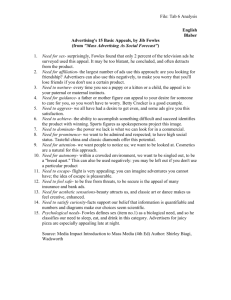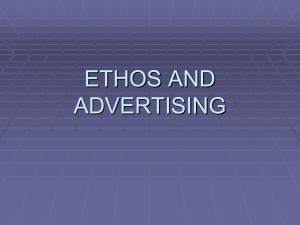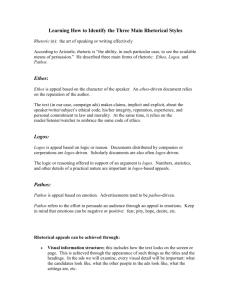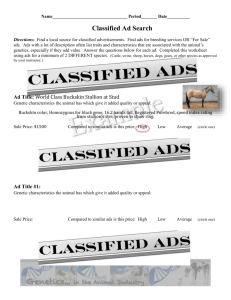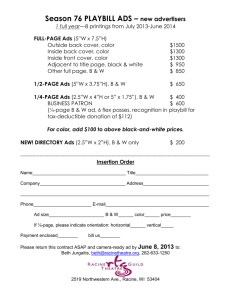After Dinner Speaking (ADS) Guide: Structure & Tips
advertisement
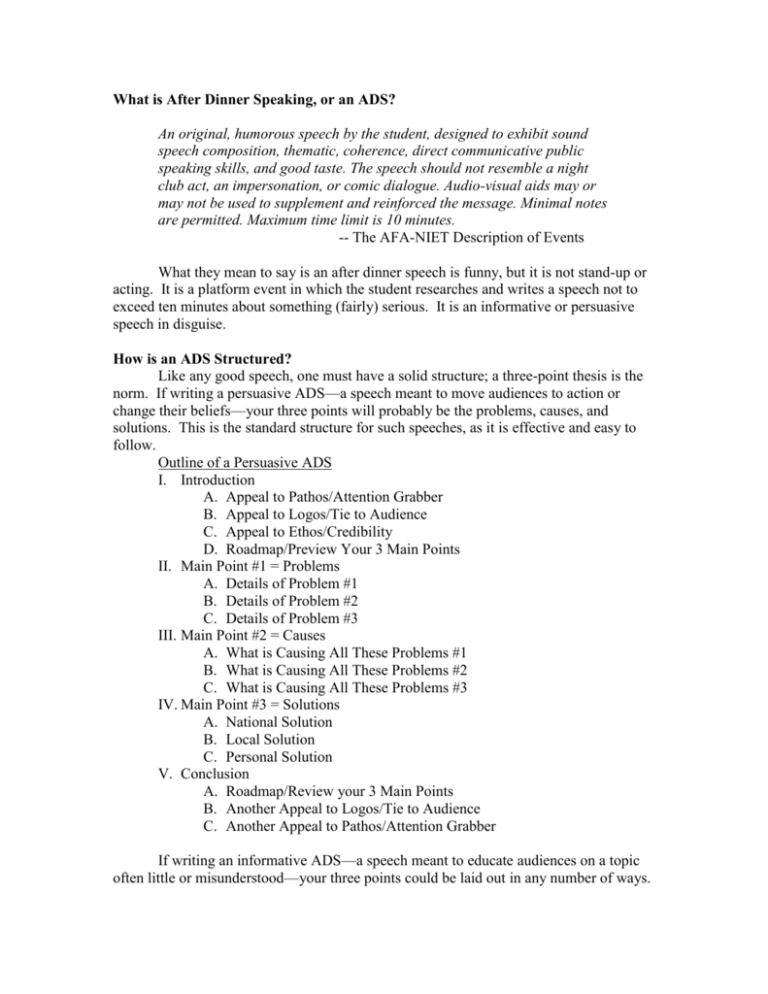
What is After Dinner Speaking, or an ADS? An original, humorous speech by the student, designed to exhibit sound speech composition, thematic, coherence, direct communicative public speaking skills, and good taste. The speech should not resemble a night club act, an impersonation, or comic dialogue. Audio-visual aids may or may not be used to supplement and reinforced the message. Minimal notes are permitted. Maximum time limit is 10 minutes. -- The AFA-NIET Description of Events What they mean to say is an after dinner speech is funny, but it is not stand-up or acting. It is a platform event in which the student researches and writes a speech not to exceed ten minutes about something (fairly) serious. It is an informative or persuasive speech in disguise. How is an ADS Structured? Like any good speech, one must have a solid structure; a three-point thesis is the norm. If writing a persuasive ADS—a speech meant to move audiences to action or change their beliefs—your three points will probably be the problems, causes, and solutions. This is the standard structure for such speeches, as it is effective and easy to follow. Outline of a Persuasive ADS I. Introduction A. Appeal to Pathos/Attention Grabber B. Appeal to Logos/Tie to Audience C. Appeal to Ethos/Credibility D. Roadmap/Preview Your 3 Main Points II. Main Point #1 = Problems A. Details of Problem #1 B. Details of Problem #2 C. Details of Problem #3 III. Main Point #2 = Causes A. What is Causing All These Problems #1 B. What is Causing All These Problems #2 C. What is Causing All These Problems #3 IV. Main Point #3 = Solutions A. National Solution B. Local Solution C. Personal Solution V. Conclusion A. Roadmap/Review your 3 Main Points B. Another Appeal to Logos/Tie to Audience C. Another Appeal to Pathos/Attention Grabber If writing an informative ADS—a speech meant to educate audiences on a topic often little or misunderstood—your three points could be laid out in any number of ways. Colorado State University’s writing website, suggests there are four ideal ways to structure your main points, but not all will be applicable, depending on your topic: chronologically, “you discuss main points in an order that could be followed on a calendar or a clock”; spatially, “you discuss main points in an order that could be traced on a map”; causally, “you discuss main points in an order that alerts the audience to a problem or circumstance and then tells the audience what action resulted from the original circumstance”; and topically, “you discuss main points in a more random order that labels specific aspects of the topic and addresses them in separate categories.” Outline of an Informative ADS I. Introduction A. Appeal to Pathos/Attention Grabber B. Appeal to Logos/Tie to Audience C. Appeal to Ethos/Credibility D. Roadmap/Preview Your 3 Main Points II. Main Point #1 = Background Information A. Detail #1 of Background B. Detail #2 of Background C. Detail #3 of Background III. Main Point #2 = Important Information A. Detail #1 of Important Info B. Detail #2 of Important Info C. Detail #3 of Important Info IV. Main Point #3 = Why it is Important to the Audience A. Detail #1 of Audience Connection B. Detail #2 of Audience Connection C. Detail #3 of Audience Connection V. Conclusion A. Roadmap/Review your 3 Main Points B. Another Appeal to Logos/Tie to Audience C. Another Appeal to Pathos/Attention Grabber While these are generally the most popular structures for this event, they are by no means the only ways to organize one’s speech. Additionally, there is an expectation for approximately 5-10 citations of sources throughout. Remember, all events vary based on the person, school, circuit, and area of the country. How to Write an ADS The first step is to choose a topic or thesis. Similar to a persuasive or informative speech, the best topic is often an intellectually interesting one, not necessarily one that is obviously laughable. Of course, there is no right or wrong choice. It is possible to find humor in almost any topic, so choose a thesis that inspires you. Second, do your homework. If you have a topic but not a thesis, research can help solidify which direction you want to take it. If you have a thesis, you can dive right into outlining your main points. Third, start writing. As a general rule of thumb, four typed, double-spaced pages will be about an eight and a half minutes, but you want to make sure you leave yourself enough time to pause for the audience’s roaring laughter. When writing, remember there is no such thing as too many jokes in an ADS. Generally, having a joke in every other sentence keeps your audience on their toes. While they do want to hear this brilliant speech you wrote, they also want you to make them laugh. It is important to keep in mind, however, the best jokes are on topic. Random cheap shots at Britney Spears, Michael Jackson, any living President, or any cast member from Jersey Shore only take up your precious time. Whatever your topic or thesis, there are a myriad of ways to make jokes of it. Use those. Fourth, start timing. While writing your various drafts, be sure to actually practice it out loud in order to time the speech. Saying it in your head won’t really cut it. You tend to go faster in your head. Remember, it must be under ten minutes, or you risk being down voted by your judges. Finally, you have to practice. Find as many people as humanly possible to practice your speech for. They will tell you which jokes work and which don’t. Ask for constructive criticism, and take it. Then you have to cut and rewrite it. Then practice some more. After that, tweak it. Find more people. Find the same people. Film yourself. Fine tune your speech as much as possible. Additionally, you may want to consider using visual aids or props to compliment your speech, but they are optional. After you take it to a tournament, use the ballots from the judges to alter your speech wherever necessary. Many of your judges will give you conflicting comments on how to improve your speech. Using your best judgment, pick and choose which suggestions you take and which you save for later. How to Judge ADS With any platform speech, an ADS should not exceed ten minutes. Ideally, the speech has a clear structure, a well researched argument with citations, is fully memorized, and performed without notes. Other expectations can include a serious point despite the humorous nature of the speech, on topic humor, cleverness, and good use of visual aids, if applicable. Competitors love getting feedback, so please feel free to fill both sides of a ballot with notes on their speech. Constructive criticism is deeply appreciated, so comments or suggestions on their delivery, structure, jokes, timing, nonverbal cues, etc. will benefit them greatly. Everyone has a different opinion, and everyone’s opinion is important. They truly want yours. How to Coach ADS For students who participated in forensics in high school, ADS and platform speeches tends to be a good way for them to make an easy transition into college forensics, because there are similar events on the high school circuit (unlike interpretive events, which have very different expectations for performed material from high school to college). There is a belief among some that only a persuasive ADS will do well, but informative structures have been gaining popularity recently and doing well. It is more important to have sound writing, research, and jokes, than to force a speech to be persuasive unnecessarily. Gina Jensen, Assistant Director of Forensics at Webster University and Pi Kappa Delta President, suggests, “Clever writing to frame serious research can be effective…Don’t let the humor allow your speech to be too shallow.”
